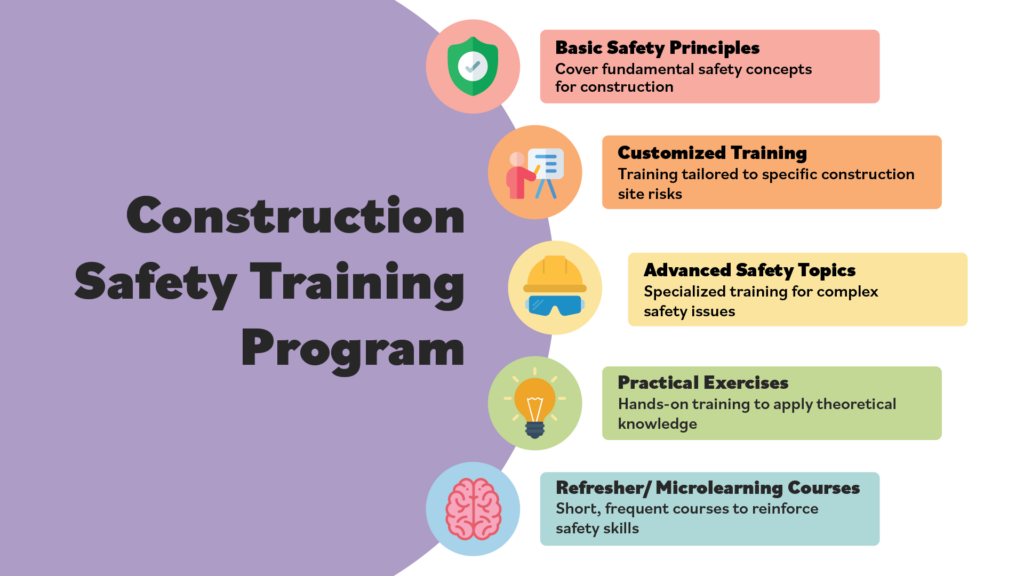How to Bridge the Skills Gap in Construction with Comprehensive Safety Training
June 17, 2024

Construction remains one of the most hazardous industries, with a high rate of accidents and fatalities. In 2022, 1,056 construction workers lost their lives, while nonfatal injuries and illnesses reached almost 170,000, according to the U.S. Bureau of Labor Statistics. These high numbers are largely due to falls from heights, struck-by incidents, electrocution and caught-in/between accidents, often referred to as the “Fatal Four” by the U.S. Occupational Safety and Health Administration (OSHA).
Many of these incidents stem from improper or insufficient safety training in a sector facing a significant labor shortage and heavily reliant on contractors with varying degrees of safety instruction. The need for skilled construction workers in the United States is critical, with the Associated Builders and Contractors estimating that the industry will need more than 500,000 additional workers by the end of the year and another 454,000 in 2025 to meet demand. Similarly, the UK projects a need for over 250,000 additional construction workers by 2028, driven by demands in private housing, infrastructure and maintenance. The skills gap in the sector is a global challenge, not confined to the US and UK alone. There are many contributing factors such as low qualifications of job applicants, high retirement rates, shifts to other industries and cultural influences that discourage young people from pursuing careers in trades.
Robust safety training programs are essential to address these challenges. Beyond ensuring regulatory compliance, organizations prioritizing worker safety through comprehensive training can achieve significant benefits: enhanced employee competence, higher retention of skilled workers, improved job satisfaction and attraction of potential employees. This blog explores the role of efficient training programs supported by digital safety management systems in reducing accidents and improving productivity in the industry.
Compliance with OSHA and Other Safety Training Requirements
Compliance with OSHA’s safety training requirements is mandatory for construction companies in the United States. Detailed in standards such as 29 CFR 1926, these regulations mandate that employers establish comprehensive safety and health training programs to ensure all workers exposed to hazards on the job site receive adequate instruction. OSHA’s requirements encompass all aspects of site safety, mandating extensive training in key areas, including:
- Hazard Communication: Training workers to recognize hazardous chemicals and understand safe handling procedures.
- Fall Protection and Prevention: Educating workers on the proper use of fall protection equipment and procedures to prevent falls from heights, which are the leading cause of fatalities in construction.
- Scaffolding Safety: Providing training on the safe erection, maintenance and use of scaffolding to prevent falls and structural failures.
- Electrical Safety: Training on electrical hazard awareness and precautions when working with or near electrical systems.
- Personal Protective Equipment (PPE): Training on the proper selection, use and maintenance of PPE to protect workers from various hazards.
- Excavation and Trenching Safety: Ensuring that workers understand the risks and safe practices associated with excavation and trenching operations.
- Confined Spaces: Training workers on the hazards associated with confined spaces and the necessary procedures to safely enter and work in these environments.
- Health Hazards in Construction: Addressing exposure to health hazards such as asbestos, lead and silica, including specific training on the safe handling and disposal of these materials.
- Emergency Response: Training workers on the appropriate response procedures for emergencies, including fire, medical emergencies and natural disasters.
Additionally, OSHA mandates other specialized training areas, including the safe use of cranes and derricks, ladders and stairways, forklifts and various tools and equipment. This ensures that workers are well-equipped to handle the diverse range of potential hazards they may encounter on construction sites.
Beyond OSHA’s requirements, construction companies follow additional standards and regulations for safety training. ANSI/ASSP standards, including Z490.1-2016 and Z490.2-2019, provide guidelines for effective training practices. NFPA 70E offers guidelines for electrical safety, while the Environment Protection Agency (EPA) regulations govern the safe handling and disposal of hazardous materials. On the global scale, the International Labour Organization (ILO) offers occupational safety and health standards applicable worldwide. Collectively, all these standards ensure the coverage of extensive preventive and protection measures in construction safety training programs and aim at achieving safe and efficient operations in the sector.

The Importance of Construction Safety Training
Besides just ticking the box for legal compliance, construction safety training programs are crucial for dealing with the unique challenges and dangers of construction sites. They arm workers with the essential skills needed to safely manage the specific risks they face on the job. Properly trained workers are more likely to follow safety protocols and use protective equipment correctly, which significantly reduces the risk of accidents and injuries. In fact, a study of 2,358 organizations found that those with sound safety training programs experienced a 24% reduction in injuries compared to those without.
Well-trained workers are more efficient and confident in their tasks, which increases productivity, decreases downtime and reduces absenteeism. This efficiency leads to higher project profitability and ensures quality and continuous improvement. Additionally, a strong safety program creates a sense of security and trust in the workplace, which results in lower turnover rates among skilled personnel.
Beyond the primary goal of protecting their workforce, investing in comprehensive safety training also enhances operational effectiveness and improves return on investment (ROI) for construction organizations. With injuries in the U.S. construction sector costing $167 billion annually, OSHA estimates that organizations implementing an effective health and safety program, including training, can expect reductions of 20% or more in their injury and illness rates and a return of $4-$6 for every $1 invested.
Key Elements of an Effective Construction Safety Training Program
An effective construction safety training program incorporates the following five key elements:
- Basic Safety Principles: Safety training programs begin with essential concepts like using personal protective equipment (PPE), fall protection and hazard communication. These basic safety principles are crucial for preventing common injuries and creating a safe work environment. Proper training in these areas helps workers recognize hazards and take appropriate precautions to protect themselves and their coworkers.
- Customized Training Program: Tailoring training to address the unique risks and tasks associated with different roles on the construction site ensures that all workers receive relevant and specific guidance. Customized training programs can address the specific hazards that workers in different positions might encounter, making the training more effective and practical. For example, a crane operator’s training will differ significantly from that of a ground worker.
- Advanced Safety Topics: Specialized training for equipment operation, ladders, scaffolding, trench safety, roofing and confined spaces ensures workers are equipped to manage complex tasks and operate equipment safely. This targeted approach helps prevent specific job-related hazards and enhances overall site safety.
- Practical Exercises: Hands-on training reinforces theoretical knowledge, enabling workers to apply their learning in real-world situations. These exercises help workers gain confidence in their abilities and understand the practical applications of safety protocols.
- Refresher and Microlearning Courses: Organizations can keep safety skills sharp and up-to-date by offering regular refresher and microlearning courses. Continuous education ensures that workers remain aware of the latest safety standards and practices, maintaining a high level of safety awareness in their daily tasks. These bite-sized learning modules are particularly appealing to the younger workforce, who generally prefer engaging and easily accessible training formats.

Figure 1: Key Elements of an Effective Construction Safety Training Program
By integrating these key elements, construction organizations can cultivate a culture of safety, where workers are more skilled, efficient and motivated.
Implementing Construction Safety Training with Intelex Training Management Software
To ensure the efficiency of their safety programs and address the challenges of training an extremely fluid workforce, construction organizations are increasingly using advanced training management software as part of their digital safety management systems. The reliance on such technology is essential in the sector where 68% of companies report that applicants lack the necessary skills for construction work, prompting 41% of organizations to increase their spending on training and professional development programs.
Intelex Training Management Software offers a comprehensive solution to streamline and enhance safety training programs. Utilizing advanced technology and comprehensive management features, this software helps construction organizations implement effective training programs, ensuring compliance with OSHA standards. Here’s how Intelex’s Training Management solution streamlines key aspects of construction safety management:
- Regulatory Compliance: Ensures all training programs meet OSHA and other regulatory standards, helping organizations avoid costly fines and enhancing overall site safety.
- Course Management: Simplifies the organization and management of training courses, allowing easy creation, assignment and tracking tailored to site-specific needs.
- Scheduling and Notifications: Automates the scheduling of training sessions and sends timely reminders, ensuring high participation rates and timely completion of necessary training.
- Training Records: Stores and manages all organization’s training data in a centralized and secure software platform, providing a clear overview of completed courses, pending sessions and overall progress for each worker. This centralized record-keeping makes it easy to demonstrate compliance during audits and reviews.
- Performance Metrics: Provides detailed reports and performance metrics to analyze the effectiveness of training programs, identifying areas for improvement to achieve desired outcomes.
- Refresher Courses and Microlearning: Offers refresher courses and microlearning modules on cell phones or smart devices through Intelex Bulletins, ensuring construction workers stay engaged, informed and up-to-date on the latest safety practices and regulatory changes.
Conclusion
In a sector facing significant labor shortages, frequent workforce changes and varying levels of safety training among contractors, effective training programs are crucial for retaining skilled workers and enhancing safety competence. By using advanced training management software, organizations are optimally equipped to achieve these goals. It provides a comprehensive solution covering all aspects of construction safety training, including course management, scheduling, automated notifications and detailed record-keeping to efficiently meet training needs in the industry.
As Scott Gaddis, Vice President & Global Practice Leader, Safety and Health at Intelex Technologies, emphasizes, “Leading EHS for over 35 years, learning and skill development have been central features in every program I have led. It is simple: my safest and best-performing organizations have always been the ones that were well-trained and had the necessary skills to do their work tasks correctly.”
By prioritizing safety training, construction companies go beyond just meeting regulations—they actively create and sustain a safer work environment. This commitment gives workers the confidence and skills to perform tasks effectively, driving the organization’s success and ensuring everyone’s safety on the job sites.







